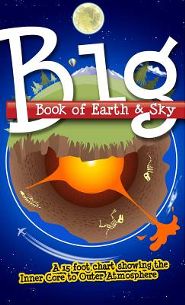The Big Book of Earth and Sky is really a book cover that encases a foldout chart that stretches to 15 feet in length. Think of it as an educational resource rather than a book that you read. You will want to view the chart vertically since it has panels that begin with the core of the earth at the bottom and the earth’s atmosphere at the top. In between, panels illustrate geological, oceanic, and atmospheric features as well as special topics such as greenhouse gases, marine fossils found high in mountains, rainbows, and cave creatures.
Heavily illustrated panels include explanatory information including occasional references to God and Scripture. It includes a panel titled “Fossil Formation and the Geologic Column” that supports a young earth explanation for the various levels of deposits.
The chart is printed on sturdy card stock and it folds down accordion-style for storage inside the book cover. Given the height of the chart, you are more likely to use it in a portable fashion so that children can easily view all of the panels. Mounting it on a wall (assuming you even have a 15-foot tall section of wall) would put the top panels out of viewing range for everyone. I can more easily envision unfolding sections of the chart at a time on the kitchen table or a low coffee table where everyone can gather around for study and discussion.
Children can explore the chart on their own, but to use it more purposely, you will want to download the free teacher’s guide from the URL listed inside the book cover. The 40-page guide provides additional learning activities for selected topics: speleology (cave studies), oceanography, meteorology (weather), and paleontology (focused on archaeology and fossils). Each of these four topics has a list of terms to know with their definitions plus a list of suggested activities. Suggestions are often general and might require additional research. For example, “Find out which oceans are the least salty and the most salty” (p. 8).
In addition, seven worksheets in the guide direct students to particular panels to search for the answers to questions on the atmosphere, mountain zones, the water cycle, precipitation, erosion, dirt layers, and layers of the interior of the earth. An answer key is at the back of the guide.
The publisher makes no age recommendation, but the chart should be of interest to children about ages seven and up. Activities in the teacher’s guide seem most appropriate for grades four through eight, but you could challenge high schoolers with the suggested activities that require further reading and research.
If you want to go deeper into any of the topics touched upon by the chart, especially if you have high school students, consider Master Books’ Wonders of Creation series that includes individual books on weather, caves, astronomy, geology, archaeology, fossils, and oceans. These books were used as source material for the creation of Big Book of Earth and Sky.










